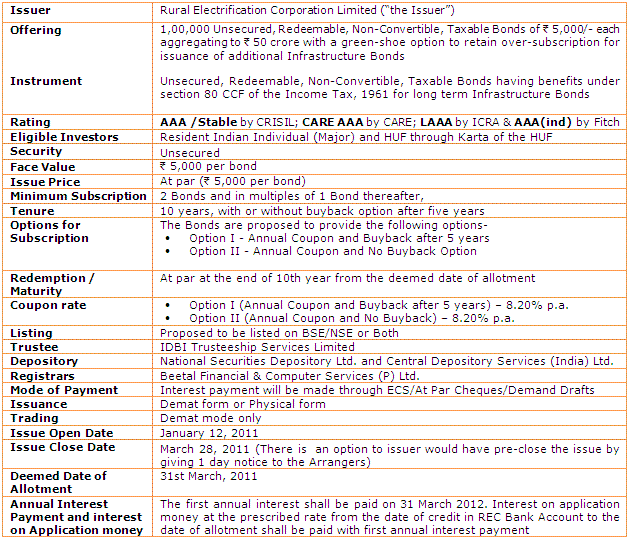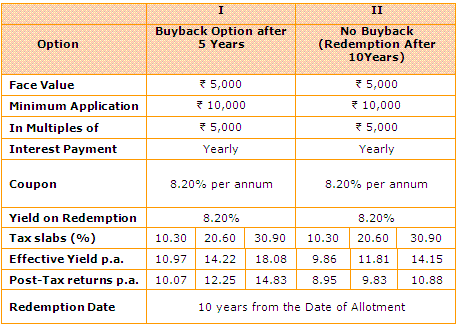In the Union Budget 2010, the Government provided an additional income tax benefit of Rs 20,000 under section 80CCF of the Income Tax Act, 1961 for investments made in long-term infrastructure bonds (as notified by the Central Government). This move was intended to provide a fillip to infrastructure finance and provide an opportunity to individual tax payers to reduce their tax liability.
In light of the same Rural Electrification Corporation (REC) Limited (“the issuer”), at present is offering these “long-term infrastructure bonds”. However, before we assess whether it is really worthwhile investing in these bonds, let’s understand the key highlights:
- What are these bonds named as?
These bonds are specifically named as “Long-term Infrastructure Bond”.
- Who would be the issuers of these bonds?
The bonds will be issued by the following entities:
- Industrial Finance Corporation of India Ltd.
- Life Insurance Corporation of India
- Infrastructure Development Finance Company Limited
- A Non-Banking Finance Company (NBFC) classified as an Infrastructure Finance Company by the Reserve Bank of India (RBI)
- When will these bonds be issued?
These bonds will be issued in the financial year 2010-11 and the volume of issuance will be restricted to 25% of the incremental infrastructure investments made by the issuer during the financial year 2009-10.
- What is the minimum tenure of these bonds?
These bonds will carry a minimum tenure of 10 years.
- Is there a lock-in period while investing?
Yes, an investor is subject to a minimum lock-in period of 5 years while investing in these bonds.
- How does one exit after the lock-in period?
After the lock-in period, the investor may exit either through the secondary market or through a buyback facility, as specified by the issuer in the offer document at the time of issue.
- What will be the yield on the bond?
The yield on the bond will not exceed the yield on Government securities of corresponding residual maturity (10 year G-Sec for this bond), as reported by the Fixed Income Money Market and Derivatives Association of India (FIMMDA), as on the last working day of the month immediately preceding the month of the issue of the bond.
- How would be the proceeds from these bonds used?
The proceeds from these bonds will be utilised for the purpose of infrastructure lending as defined by RBI (as per the guidelines issued by it).
- Is interest earned on these bonds taxable?
The interest received in these bonds is not tax free. The investor is liable to pay tax on the interest received.
The interest received on these bonds shall be treated as income from other sources and shall form part of the total income of the assessee in that financial year in which it is received. However no TDS shall be deducted on the interest received as these bonds if issued in Demat mode and listed stock exchange.
The details on the “long-term infrastructure bonds” offered by the issuer REC Ltd. are as under:

Note:
- PAN card is mandatory for subscribing to these bonds. A self attested copy shall be enclosed along with the application form.
- Chq / DD should be drawn in favour of "REC Long Term Infra Bond". It should be crossed A/c payee only.
Investors’ will also have the following options available at the time of subscribing to the issue:

(Source: Application form of REC Ltd. & PersonalFN Research)
Well, after reading the details of the scheme, there may be still some more questions popping up, which are attempted to answer herein:
- Can one invest in both the options?
Yes, one may invest in both the options. The bonds can be of the same series or 2 bonds across different series.
- Can one apply in joint names?
Yes, one may apply in a joint name (with a maximum of three applicants). However, the demat accounts will also be required to be held in joint name and the order of applicant shall be the same as appearing in the demat account. Moreover, the tax benefit can be availed only by the first applicant.
- Who will get the interest in case of joint application?
In case of joint application, interest will be paid to the account of the first holder only.
- My demat account is in joint name, but I want to apply is a single name?
In case of a single application, demat account of the same single applicant would be necessary. Joint demat account would not do.
- Can one pledge or lien or hypothecate the bond, while obtaining a loan from a scheduled commercial bank?
Yes, one may pledge or lien or hypothecate the bond, while obtaining a loan from a scheduled commercial bank. However, this can be done once the said lock-in period is over.
TAXATION OF LONG-TERM INFRASTRUCTURE BONDS:
Your investment in these “long-term infrastructure bonds” will be eligible for a deduction under section 80CCF of the Income Tax Act, 1961 subject to a maximum limit of Rs 20,000. This deduction limit of Rs 20,000 will be over and above Rs 1,00,000 benefit available under section 80C, 80CCC and 80CCD.
However, the interest earned by you on the investments (in these bonds), will be taxed (they would be included in the “Income from Other Sources”, in the financial year in which it is received). However, since these bonds are issued in a demat as well as physical mode and listed on the exchange, no Tax Deduction at Source (TDS) will be done on the interest received under the demat mode.
OUR VIEW:
In our opinion investments in REC’s long-term infrastructure bonds, appears enticing from a tax planning perspective, as an investment upto Rs 20,000 will be eligible for an additional (over and above Rs 1,00,000 benefit limit available under section 80C, 80CCC and 80 CCD of the Income Tax Act, 1961) tax benefit.
It would not be prudent to invest an amount over Rs 20,000, as the excess investment amount over Rs 20,000 will not be eligible for income tax benefit under section 80CCF. Also we are in a scenario of rising interest rates, whereby going forward there may be such other offerings under section 80CCF by the eligible issuers, which may offer a better rate of interest along with tax benefit.
As regard the question which series to invest is concerned; it is prudent to invest in the non-cumulative buy-back option for the high post-tax yield offered by it. However, while opting this, investors should ideally invest the pay-outs received by them in higher yielding securities (offering interest over 8.20%) in order to enjoy higher benefits.
However, if an investor favours annual coupon payments and is ready to lock his funds for 10 years then the non-cumulative non-buyback option is suitable.
Add Comments